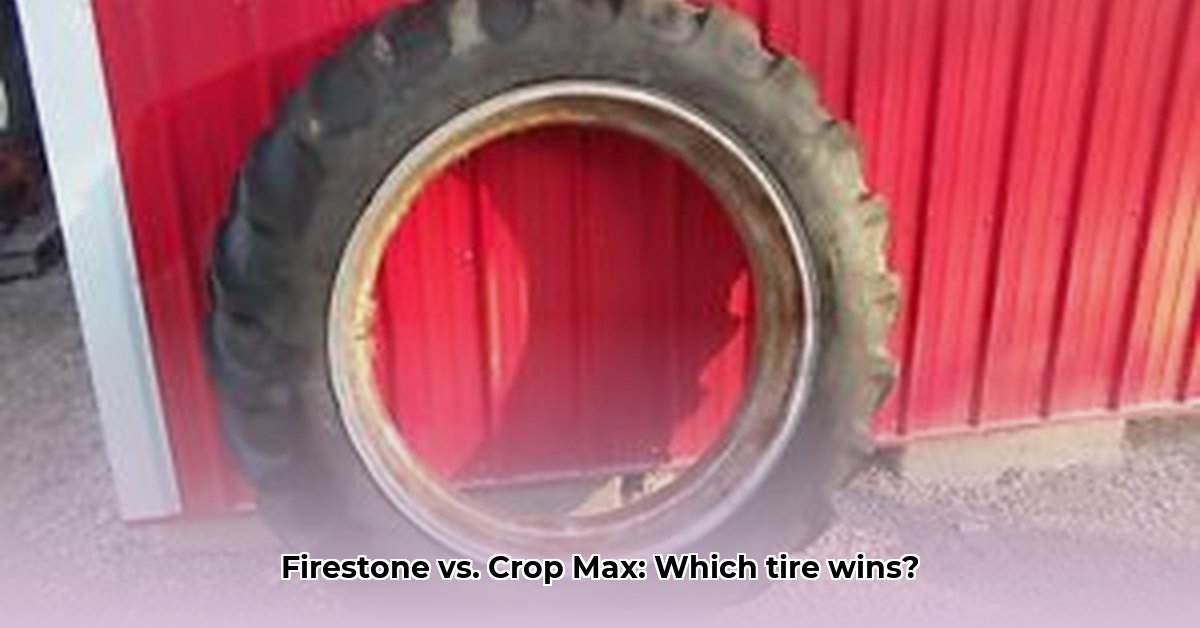
Choosing the right tires for your 11-38 tractor significantly impacts fuel efficiency, soil health, and your farm's overall profitability. This comparative review analyzes two leading contenders—Firestone Field & Road and Crop Max Irri-Pro—examining their performance, sustainability, and lifecycle costs to help you make an informed decision. For more on tractor tire sizes, see this helpful guide: Tire Dimensions Explained.
Tire Specifications: A Side-by-Side Comparison
Direct comparison of the Firestone Field & Road and Crop Max Irri-Pro tires requires more detailed manufacturer specifications than are currently publicly available. The following table highlights key features where information is accessible, emphasizing areas needing further research.
| Feature | Firestone Field & Road | Crop Max Irri-Pro | Notes |
|---|---|---|---|
| Size | 11-38 | 11-38 | Both tires fit the same tractors; performance and longevity are key differentiators. |
| Tread Depth | Data Needed | Data Needed | Impacts tire lifespan and traction across varying soil conditions. |
| Tread Pattern | Data Needed | Data Needed | Affects traction, soil compaction, and fuel efficiency. |
| Load Capacity | Data Needed | Data Needed | Crucial for matching tractor weight and load requirements. |
| Rolling Resistance | Data Needed | Data Needed | Lower rolling resistance translates to better fuel efficiency and reduced tire wear. |
| Material Composition | Standard agricultural rubber; specifics needed. | Likely includes ozone-resistant compounds; specifics needed. | The rubber composition significantly impacts both durability and environmental impact. |
| Approximate Pricing | Varies by retailer and market conditions. | Varies by retailer and market conditions. | Always compare prices across multiple retailers to ensure best value. |
| Recycling Potential | Data Needed | Data Needed | A critical assessment in the context of sustainable tire lifecycle management. |
Performance Comparison: Traction, Soil Compaction, and Fuel Economy
Quantifiable data on the performance characteristics of both tires across various soil types (clay, sandy loam, etc.) is currently unavailable. Further research, including independent field tests, is necessary to provide a complete comparison of traction, soil compaction levels, and fuel efficiency. However, we can make some general observations:
- Traction: Both tires are designed for robust traction, but the specific performance across diverse soil conditions remains to be determined. Tread pattern and depth will be key factors determining effectiveness.
- Soil Compaction: Tire width and pressure significantly influence soil compaction. While more research is needed, wider tires generally cause less compaction than narrower ones, assuming comparable tire pressures.
- Fuel Efficiency: Lower rolling resistance directly correlates to better fuel efficiency. However, without precise rolling resistance data for each tire, a direct comparison is currently impossible.
Sustainability Assessment: Environmental Impact Analysis
A thorough lifecycle assessment (LCA) is needed to fully evaluate the environmental impact of the Firestone Field & Road and Crop Max Irri-Pro tires. Key factors to be considered include:
- Material Sourcing: The use of recycled materials or bio-based rubber in tire construction directly affects the environmental footprint. Data on the percentage of recycled or sustainable materials in each tire is needed.
- Manufacturing Processes: Energy consumption and emissions during the manufacturing process are crucial sustainability indicators. Data on these processes for each tire is currently unavailable.
- End-of-Life Disposal: Responsible tire disposal is essential. Assessing the recyclability and potential for repurposing of each tire is critical. Currently, this information is unavailable for both tires.
- Carbon Footprint: A comprehensive LCA will provide a detailed breakdown of the carbon footprint associated with the entire lifecycle of each tire, from raw material extraction to end-of-life disposal.
Cost Analysis: Total Cost of Ownership
A comprehensive cost comparison requires more data. While the Crop Max Irri-Pro might have a higher initial cost, its potential advantages in fuel efficiency and longer lifespan could lead to significant long-term cost savings. A detailed cost-benefit analysis needs to incorporate:
- Initial Purchase Price: Obtain quotes from multiple retailers for both tire models.
- Fuel Consumption: Estimate fuel savings based on the rolling resistance (once data are available).
- Tire Lifespan: Determine the expected lifespan of each tire, factoring in operating conditions.
- Replacement Costs: Calculate the total cost of replacement over the expected lifespan of each tire.
- Disposal Costs: Consider the cost of environmentally sound tire disposal.
Conclusion: Making the Right Choice for Your Farm
Choosing between the Firestone Field & Road and Crop Max Irri-Pro tires requires a careful evaluation of your priorities and farming practices. While a definitive recommendation is impossible without more comprehensive data, we can outline a decision-making process:
- Prioritize Needs: Identify your top priorities – minimizing soil compaction, maximizing fuel efficiency, or optimizing cost-effectiveness.
- Gather Data: Actively seek out detailed specifications from tire manufacturers, independent testing results, and lifecycle assessments.
- Perform Cost-Benefit Analysis: Utilize the factors outlined in the cost analysis section to estimate the total cost of ownership for each tire.
- Consider Sustainability: Evaluate the environmental impact of each tire based on available information on material sourcing, manufacturing processes, and end-of-life management.
- Consult Experts: Speak with agricultural professionals and other farmers to gather practical insights and real-world experiences.
This review highlights the critical need for more readily available data to facilitate informed decision-making for sustainable farming practices. As more information becomes available, this comparison will be updated to provide even more precise guidance.